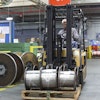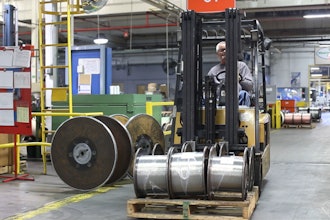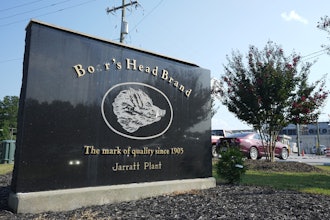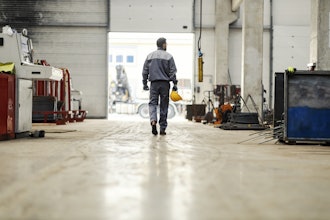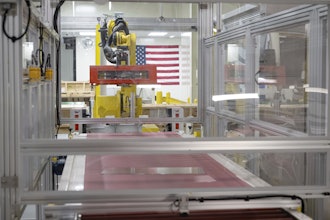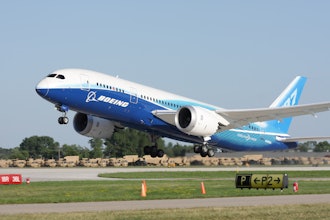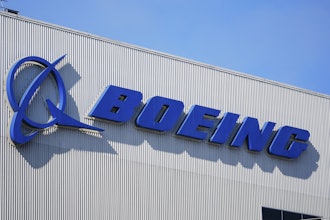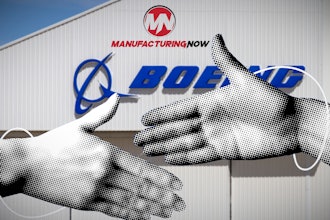This article first appeared in IMPO's March 2013 issue.
Leading development partner for the transportation industry with a global operating workforce of over 5,600, EDAG (Detroit, MI/Fulda, Germany) recently was faced with the task of designing a heavy-duty ring for a new production concept. The system, designed for small lot production of vehicle components, was required to not only bear the weight of car body tools weighing up to four tons, but also provide sufficient room at its center for a heavy-duty robot.
At the initial stages of development, EDAG engineers found that the heavy-duty rings currently available on the market were too small to bear the weight of four heavy car body tools while providing sufficient room for handling systems and a robot in the center — not just the outside of the ring. EDAG’s Managing Director/COO Manfred Hahl swiftly sought out a solution to the new production concept that would ultimately provide its customers cost advantages and quality-enhancing innovation.
Hahl commissioned industry leading specialist for rotary tables and automation WEISS North America, Inc. (Willoughby, OH), and its’ parent company WEISS (Buchen, Germany), to initiate detailed and collaborative engineering discussions with them to develop a complete, integrated solution for EDAG’s unique production system.
Based on its‘ powerful CR series range of heavy-duty rings, which feature large open centers, WEISS North America began customized engineering specifications on a unique CR 2600 rotary table that could ultimately accommodate four tools, and a robot in the center.
After a few rounds of reviews between EDAG and WEISS, the design goals became clear; design a rotary table that can efficiently accommodate four tools. While production is underway at one or two positions, the free positions must then be either manually or automatically equipped with new tools, ensuring fast availability. The table should also feature sufficient space in the center for a robot to carry out both machining and logistics functions, thus permitting space saving while enhancing the flexibility and productivity of the system.
Key specifications for the new CR 2600 heavy-duty ring quickly came into focus:
- A permissible vertical axial 500kN dynamic and 1000kN static force on the drive plate.
- A central opening of 2 meters and a freely programmable drive.
- A low installation height of only 300 millimeters to enable
stepless, ergonomically favorable manual loading alongside automatic loading. - Implementing WEISS Application Software (WAS) to ensure fast set-up and uncomplicated integration into all production cycles.
Additionally, the new member of the WEISS CR family would inherit all the positive design characteristics of the series’ range: a flat design, zero backlash, and optimum power transmission, as well as a drive unit positioned far to the outside which can easily be taken into operation with WAS.
According to Stanislav Cafuta, a WEISS system developer, “The key was designing the ring‘s central opening with a diameter of two meters, tool weights of up to 20 tons, and a reach of up to 2.5 meters – demands which even our largest heavy-duty rings were unable to meet at the time.”
Featuring a distinctly large central opening, the new CR 2600 is a unique combination for this size of a classic rotary table and shuttle system in which robots can access the workpiece from both sides. The system is currently running with two tools for two components, so that the rear hatches and bonnets can be manufactured in a combined process.
According to WEISS North America’s Vice President, Bill Eppich, “Ultimately, the CR 2600’s unique configuration opens up other possibilities for the installation that sparks the imagination. This is due to the user-programmability of the table, as well as savings in floor space brought about by the option of positioning even large robots at its center.”
EDAG’s Hahl expands on these possibilities, stating, “For example; if an opening of two meters can accommodate one large robot, then there is room for two or more small robots. In addition, four or more different tools can be used instead of the current 2+2. As a result, it is possible to either produce four different door types for small lots on one installation, or provide four different tools in quick succession in a similar manner as a turret on a machining center.
“The free positions can also naturally be used for logistics and equipping the tools,” Hahl concludes. “Therefore, the heavy-duty ring’s low height of only 300 millimeters is very convenient — enabling ergonomically favorable, stepless manual loading alongside automatic loading.”
